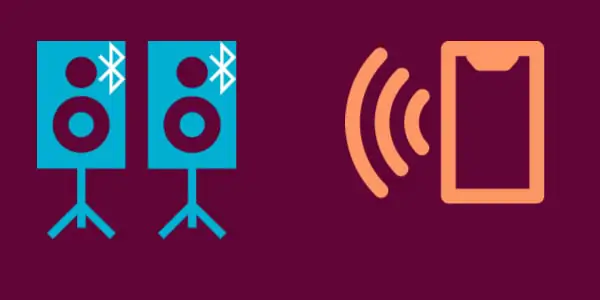NFC On Bluetooth Speakers
Over the years, devices have communicated with one another by different means. We have a regular cable or wired connection, which is still a communication method for many devices and wireless communication methods such as Wi-Fi Direct, Bluetooth, and, more recently, Near field communication- a short-range communication method better known as NFC.
Before devices can connect wirelessly, there must be a shared medium that allows them to get to know each other before the transfer of files can occur between them. Usually, this happens without intervention as soon as one device detects the other device close to it. This process is known as pairing. However, this process sounds straightforward, it takes some time before it can occur, and it becomes even more difficult if there are several devices within range. Modern appliances have succeeded in reducing the time needed to pair one device with another to just a few seconds. This connection time and the difficulties associated with device connection when several appliances are in range does not exist with Near Field communication.
What is Near Field Communication (NFC) on Bluetooth Speakers?
Near Field Communication on Bluetooth Speakers is a short-range communication method that is used by speakers today. It allows speakers to share information easily with other NFC enabled devices. One key feature of this communication technology is that it has a minimal range (about four centimeters), thereby requiring the appliances to be near each other. The devices utilize an NFC tag (a smart microchip that enables NFC enabled devices to read data embedded in the chip). Interestingly, NFC readers must not necessarily be specialized devices. Most NFC chips are integrated right into the circuitry of the smartphone.
NFC devices fall into two classifications. They are:
1. Passive devices.
2. Active devices.
Passive devices contain information that can be read by other NFC enabled devices. However, they are unable to read data from other NFC enabled devices.
Active devices contain information that can be read by other NFC enabled devices. These devices also possess the capability to read data from other NFC enabled devices. An excellent example of these devices is NFC enabled smartphones that can both read information from NFC tagged posters and also share files and documents with other NFC enabled smartphones. It can even go as far as altering the information on the NFC tag if given authorization.
Advantages of NFC on bluetooth speakers
NFC technology is highly recommended by professionals familiar with the technology. Some of the reasons for this recommendation include:
1. Ease of connectivity
Unlike other means of device communication such as Bluetooth and wireless, which requires some time to pair devices before files can be shared between them, NFC does not require pairing or manual configuration, thereby making the connection seamless. Connecting devices enabled with Near Field communication takes less than a second
2. Bootstrapping other wireless connections
One exciting feature of Near Field communication is that it can be used to initiate contact for wireless communication methods such as Bluetooth and Wi-Fi. NFC eliminates the tedious processes involved in pairing devices with Wi-Fi and Bluetooth since it is capable of sending and receiving digital markers easier and faster.
Disadvantages of NFC on Bluetooth Speakers
Some cons of using NFC are below:
1. Slower Connectivity
One crucial drawback of Near Field Communication is that it is not very useful or efficient when it comes to data transfer rates. This means that it would not be helpful in the transfer of large files or documents. The maximum transfer rate for NFC is 424kbps, while Bluetooth 2.1 has a transfer rate of 2.1Mbps.
2. Limited working range
The maximum working distance for NFC is 4 centimeters, while class 1 Bluetooth has a maximum range of about 100 meters. However, because of NFC’s bootstrapping ability with other wireless communication methods like Bluetooth and Wi-Fi, it serves as a technology for supplementing these other wireless communication technologies.
3. Increased Cost implications resulting from bootstrapping with other wireless communication methods
While the bootstrapping capability of NFC is to be admired, this feature of NFC nullifies its cost advantage for many applications. Since it is not ideal to use NFC as a standalone wireless communication method in applications such as computers and smartphones, it is used to supplement other, more conventional wireless communication methods. In such applications, the cost advantage of Near Field Communication is lost.
Uses of NFC in Bluetooth
The prevalence of NFC and the increased awareness of the technology means that manufacturers, store owners, and others utilize Near field communication for different applications. These applications range from essential functions to more complex applications. They include the following:
1. As a payment platform
NFC makes it straightforward for users to make instant payments through their smartphone or tablet. Mobile wallets offered by Google or Apple make this process possible. In many convenience stores around the world, contactless payment is now the norm. Applications such as Google Pay or Apple Pay makes it possible to utilize this type of payment system. Choosing to use NFC payments eliminates the need to carry credit cards or other payment methods alongside your smartphone.
2. Instantaneously connect to a Wi-Fi network
One disadvantage of a secure Wi-Fi password is that it is usually lengthy and complicated in an attempt to make the password difficult to decipher. This makes the process of connecting to the Wi-Fi network tedious. This can be resolved by writing the Wi-Fi password onto an NFU tag, and a single tap on the tag with an NFU enabled device will pre-populate Wi-Fi connection details and get the user online without any difficulty.
3. Connections to media devices like Bluetooth speaker
Many modern Bluetooth speakers come equipped with Near Field Technology. One prime example is the Sony XRS XB33 speaker with NFC as one of its key features; this enables smartphones to easily connect with these speakers in a fraction of a second, eliminating the tedious process of pairing the Bluetooth speaker with the NFC enabled device. After a connection has been established, the media file can then be played through the speaker’s Bluetooth feature, thereby increasing the range of usage.
4. Share media with Android Beam
One feature of modern smartphones that run on the Android platform is the presence of Android Beam. This feature makes it possible to share content from the screen of one device to another device by directly bringing the appliances together. This content ranges from media files to contacts and even webpages. The Near Field Communication feature of the android device must be on to share content successfully.
NFC in the Future
The potential applications of NFC are staggering, especially in crucial sectors of the economy like transportation, advertising, and hospitality. Outlined below are ways these sectors stand to benefit from NFC.
Transportation
This sector of the economy stands to benefit a great deal from Near Field Communication technology. An enormous challenge facing public transportation systems worldwide is the sheer number of passengers seeking to get a ticket to board trains or buses. Contactless tickets will help to increase the speed and ease with which consumers can utilize these means of transportation. It also decreases wastage of resources such as paper that would have been used to print tickets, making it an environmentally friendly solution.
Advertising
Near Field Communication applied in the advertising sector can improve the advertising experience for the end-user. Information can be exchanged regarding products using posters embedded with an NFU tag that easily be accessed using an NFU enabled device and read at the convenience of the reader. One benefit of utilizing this method of advertising is that the reader does not need to stand facing the poster to read the information on it. It can be conveniently read anywhere by the reader and anytime. Another advantage of this means is that the data saved in the NFU tag must not be according to the size of the banner or its visibility, this leads to a significant increase in the quality and quantity of the information exchanged.
Hospitality
Businesses that offer customer services such as restaurants and hotels can benefit significantly from this technology. NFC tags can easily and quickly deliver information such as menus, promotions, and Wi-Fi passwords to customers. Also, tourist hotspots such as museums and parks can benefit from this technology by utilizing Near Field Communication tags to easily store and deliver information regarding historical events, descriptions of sculpture, statues, and even artwork, thereby improving the visitor’s experience.
Near Field Communication technology has come to stay. NFC tags are used in various ways today, ranging from its usage as a medium of payment for bootstrapping other conventional wireless communication technologies and the transfer of files. NFC tags also have the potential to play an even more prominent role in the economy’s vital sectors. The future is undoubtedly bright for Near Field Communication (NFC) technology.

Sam has been a Smart Things expert for years and the author of DIY SmartThings. Recently he’s really more into Nest smart devices and has a lot of experience with all sorts of projects from converting a regular Home to completely a smart home with the background degree in Electronics.
